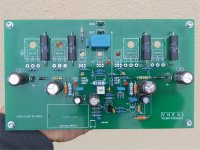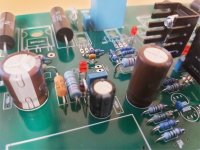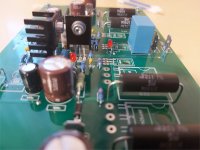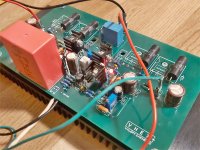Came up with an update - super-balanced, less distortion front-end here:
DiagoHex+
It's a single-LTP, but push-pull current-driven VAS.
A single-layer one-output-pair PCB will easily fit the size of original VHex one, developed by Albert some time ago.

Thank you Valery.
Hi, I have a problem with the VHE+ boards , in one channel I have in the point 2-2 35mV and 1-1 28mV
Hi, I have a problem with the VHE+ boards , in one channel I have in the point 2-2 35mV and 1-1 28mV
You mean VHex+ ? Send a pm to Valery. 😉
Hi, I have a problem with the VHE+ boards , in one channel I have in the point 2-2 35mV and 1-1 28mV
Hi Patriz,
On one hand - it most likely means relatively high tolerance throughout your output devices in terms of Vgs. On the other hand - not a big problem.
Did you match the output transistors?
Can you please measure the voltage drop over each source resistor (0.22R) separately?
Did you set zero DC offset at the output (some millivolts is fine)?
Cheers,
Valery
Hi Valery,
I got the board from a forum member so I don't know if he matched the output devices.
On Irfp9240 source resistor I have 17 and 16mV on Irfp240 I have 14 and 13mV.
Output offset is 1mv.
The previous owner changed R29 to 680R but I have to take it back to 560R because I can't set a higher bias as it is now with my power supply (45V).
I got the board from a forum member so I don't know if he matched the output devices.
On Irfp9240 source resistor I have 17 and 16mV on Irfp240 I have 14 and 13mV.
Output offset is 1mv.
The previous owner changed R29 to 680R but I have to take it back to 560R because I can't set a higher bias as it is now with my power supply (45V).
Hi Valery,
I got the board from a forum member so I don't know if he matched the output devices.
On Irfp9240 source resistor I have 17 and 16mV on Irfp240 I have 14 and 13mV.
Output offset is 1mv.
The previous owner changed R29 to 680R but I have to take it back to 560R because I can't set a higher bias as it is now with my power supply (45V).
That's actually fine. So, if we take the highest pair (17+14) and the lowest one (16+13), we have 31mV and 29mV accordingly. No problem - there's always some difference due to components' tolerance.
560R - good, it will move the bias threshold to higher values.
Don't forger to set the trimmer into the "minimal bias" position befor you power it up after the resistor replacement 😉
I recommend to set 35-37mV across the pairs of source resistors (80-85mA quiescent current after, say, 20 minutes warm-up at idle).
The "pairs" are actually "artificial" - the circuit "does not know" anything about particular pairs - each output device is working on its own. That means, you can measure 1-1, 2-2, 1-2 and 2-1, testing all combinations for those "virtual pairs".
I hope you like the sound 🙂
Cheers,
Valery
It would likely be a good idea to change the bias pot to 200R. The VHex+ normally start up with a couple mA of bias current flowing with the pot at max and R29 at 560R. That's likely why the previous builder changed to 680R.
It would likely be a good idea to change the bias pot to 200R. The VHex+ normally start up with a couple mA of bias current flowing with the pot at max and R29 at 560R. That's likely why the previous builder changed to 680R.
Yes - good one. Safer.
VHEX+ Made in Hungary
Today afternoon I finished my VHEX+. The PCB was designed by me, it contains only THT parts. The amp is dead silent, no hum, no noise. Sound very powerful and dynamic, no audible distortion even close to clipping. It sounds natural and clean (sometimes too clean). VHEX+ is the most tonally correct and rhitmically accurate amplifier I ever heard. Thank you Valery for share this great design. It's my reference amplifier.
Today afternoon I finished my VHEX+. The PCB was designed by me, it contains only THT parts. The amp is dead silent, no hum, no noise. Sound very powerful and dynamic, no audible distortion even close to clipping. It sounds natural and clean (sometimes too clean). VHEX+ is the most tonally correct and rhitmically accurate amplifier I ever heard. Thank you Valery for share this great design. It's my reference amplifier.
Attachments
- Home
- Amplifiers
- Solid State
- IRFP240/9240 Amplifier (simulated on TINA)



